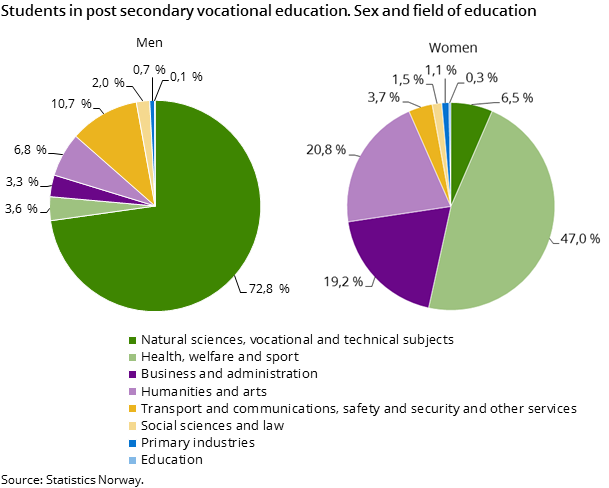Fewer students choosing post-secondary vocational education
Published:
In the autumn of 2016, 14 750 students were registered in post-secondary vocational education programmes in Norway. This is 400 fewer than in 2015 and 1 200 fewer than the peak year of 2014.
- Series archive
- Post-secondary vocational education (archive)
The reduction is seen in the number of students registered in two-year post-secondary vocational education programmes. programmes, with 600 fewer students in 2016 than in 2015. On the other hand, post-secondary vocational education programmes with a duration of less than two years saw an increase of 200 students compared to 2015.
The total decrease in the number of students can also be attributed to the drop in the number of male students. In 2016, there were 730 fewer male students compared with 2015, while the number of female students has increased by 330 in the same period. The number of institutions offering post-secondary vocational education has also decreased by approximately 10 each year since 2013, according to the Database for Statistics on Higher Education (DBH).
-
More figures and tables from the statistics Post-secondary vocational education.
Many adult students
Forty-one per cent of students in post-secondary vocational education were over the age of 30, and nearly 20 per cent were over 40. Post-secondary vocational education builds on upper secondary education, and the age composition suggests that it is common to have a break between upper secondary and post-secondary vocational education.
Figure 2. Students in post-secondary vocational education
| 2011 | 2012 | 2013 | 2014 | 2015 | 2016 | |
| Men and women | 11744 | 14370 | 15495 | 15970 | 15146 | 14748 |
| Men | 7395 | 8455 | 9548 | 9946 | 9411 | 8678 |
| Women | 4349 | 5915 | 5947 | 6024 | 5735 | 6070 |
Contact
-
Jane Bekkengen
-
Geir Nygård
-
Sadiq Kwesi Boateng
-
Statistics Norway's Information Centre

